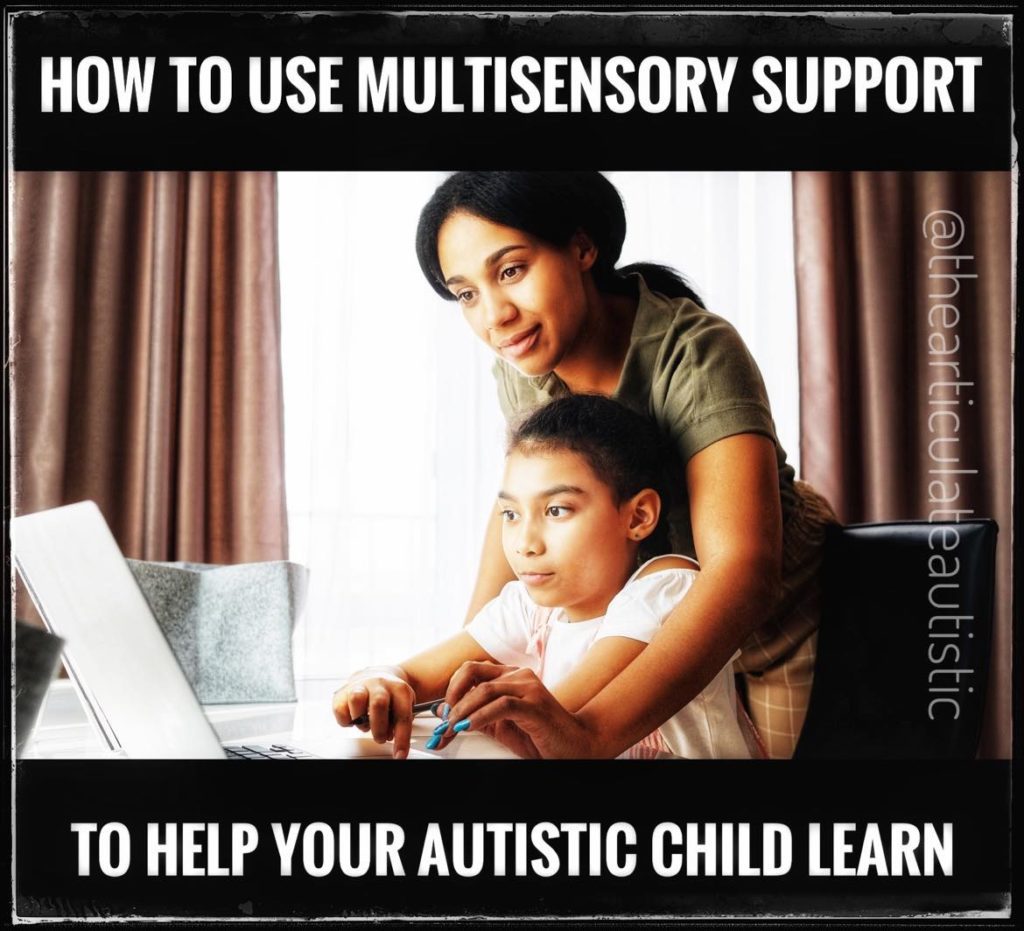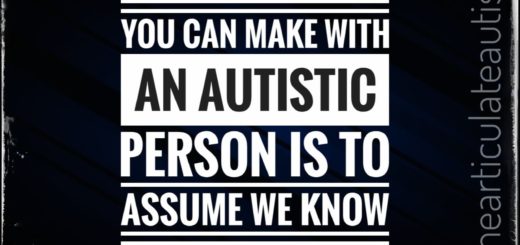How to Use Multisensory Support to Help Your Autistic Child Learn New Information and Become More Independent

Like many autistic people, I’m a multisensory learner. This means that I don’t just learn one way; visual, auditory, kinesthetic, etc., I learn best when all or most of my senses are involved.
I think this is one of the reasons I need to use closed captioning when I’m watching TV. I do have auditory processing disorder, and I process auditory information much slower than I do visual. However, I think that having both auditory input and reinforcing visual input helps “bring everything into focus” in my brain, so to speak.
Binoculars In Focus – My Multisensory Processing Style
If you’ve ever used binoculars, you know it takes a few tries to get both lenses to work together and get a picture into focus. But, once the focus is there, you can see perfectly!
For me, using the TV example, the auditory information coming from the speaker is one lens of the binocular, so, without the visual information from the closed captioning (the “other lens” of the binocular), I’m not getting the whole picture.
Each reinforces the other so that my brain produces a whole picture, and I can more fully immerse myself in the story without feeling lost half the time.
Simply integrating two of my senses in learning and processing has made a world of difference for me, and it might be useful in improving your communication with your autistic loved one!
What Is Multisensory Support?

From what I understand, neurotypical people teach other neurotypical people how to do something by explaining once or twice, maybe showing it once or twice, and then leaving the neurotypical person to do it on their own.
This doesn’t work for me. It never has. Because I am slower to process auditory information, a person can’t just verbally explain to me what it is they want me to do and have me remember it and be able to carry out the task.
I won’t be able to because not only do I have slower processing time when it comes to auditory input, but my working memory and short-term memory are both terribly impaired.
Because of this, in order to learn new information, I need a multisensory approach. This means I need to hear the instructions, write the instructions down step by step in a very detailed fashion, read the instructions out loud and back to the other person for confirmation of understanding, physically do the activity while listening to the other person give me the instructions again, and then read my own written instructions and do the activity over and over and over again until the ability to do it is ingrained not only in my long-term memory but in my body, as well.
I have to have muscle memory to draw on when the information inevitably leaks out of my brain.
This is the only way I can do something independently.
This is how I learned to drive. (It was painful for both my driving instructor and my poor dad to teach me, but it’s how I learned.) I had no idea that’s what was happening at the time or that it’s what I needed, but driving did not click for me until I had taken a very long break between lessons, and suddenly, I was able to do it. It’s like my brain just needed the extra time to process the bits and pieces I’d learned and put it all together into one cohesive set of instructions.
Why I’d Prefer People Didn’t “Presume Competence”

Lately, I’ve been seeing a lot of “presume competence” in autistic advocacy spaces, and while I agree with the intention of this sentiment, I think it can actually cause harm if used in the wrong context.
Should you assume autistic people are incompetent? No, not at all. The problem doesn’t lie in whether or not the autistic person is capable of learning but whether or not the autistic person is going to be able to learn information presented in a neurotypical way.
While the drive to learn may be there, the ability with the available tools may not be. This isn’t because the autistic person isn’t intelligent, it’s because the autistic person often learns differently from how their neurotypical counterparts do.
For example, while most neurotypical people learn implicitly, by simply being in their environment, observing others, and through more subtle, indirect means, autistic people often learn explicitly, as in we need to be specifically taught a neurotypical social skill or an everyday practical skill in order to learn it.
So, presuming competence can often look like assuming the autistic person learns the same way a neurotypical person does, which can cause the neurotypical person doing the teaching to skip over “unnecessary” steps in their explanation because “everybody knows that”.
I need every single step explained to me. Nothing is “implied’, and even if it was, I, personally, would prefer to have someone over-explain something than assume I know. That’s because assuming that even one of the steps of something I’m being taught is “common knowledge” can completely derail my ability to learn.
How to Offer Multisensory Support to Your Autistic Child
The first step to teaching an autistic person anything is to be 100 percent sure we are fully engaged in the experience before beginning.
I know this may seem like something I shouldn’t have to explain, but it’s crucial to the autistic learning process.
Too many times I hear, “But, I told her 100 times!” Yes, but when did you tell her and how? Was she distracted by a video game? Was she tired? Was she in a state of sensory overload? Did you walk past her room and toss off the request as you walked away with a load of laundry? Was she able to see your voice, hear your words, and fully understand your instructions, or did your voice and request get lost in the sound of the TV, the dog barking, the stereo blasting at your neighbor’s house, and the drone of the dryer?
So, I reiterate:
Before teaching, explaining, or saying anything to your autistic loved one, be sure you have their full and undivided attention.
Once you do, offer:
- Visual supports
Let’s say you have an autistic teenager you want to be responsible for taking out the trash, simply asking, “Will you take out the trash?” may not be enough. A visual chart of the chores your autistic teen is expected to do can go a long way in helping them to remember what to do and gain more independence as time goes on.
- Written instructions
Story time: When I was a child, I knew very early on that I didn’t remember things the way other kids did, so, being my clever and innovative self, I started carrying a notebook around with me to write every instruction I was given down.
It felt like a punch to the gut when the notebook was taken away from me because I “didn’t need it”, and I was just “doing it for attention”.
Allow your autistic loved one to write down every single detail of what you say if that’s helpful to them. Even if it’s a step you swear they will remember or it is “common sense”, just let them write it down. Sometimes, the simple act of writing it out can be enough for it to stick better in my brain.

- Extra processing time
Many autistic people need more time to process and integrate new information than our neurotypical counterparts. If you try to explain something too fast, or if you throw too much information at us at once, we won’t be able to take it all in fast enough before you move on. Slow down, chunk information, and allow us extra processing time.
- Physically acting out the instruction
Whenever I was working at a new job or learning a new task at an existing job, I had to physically act out whatever it was they were trying to teach me. I couldn’t just sit and watch and then do it on my own later. I had to physically feel what I had to do and do it while I read from the notes I had taken during verbal instruction. Did people think it was weird? Yes. Did I care? No. Allow your autistic loved one to act out the instruction as many times as necessary to achieve understanding.
- Relate existing knowledge to new information
This one is so important! Neurotypical people seem to be able to take what they’ve learned in a similar situation, apply that knowledge, and then add or subtract from it based on context cues. Many autistic people can’t do that without outside assistance to start. New information can be more efficiently learned if the person doing the teaching relates existing knowledge to the new task or rule being learned. This teaching technique is called scaffolding, where new knowledge is built on existing knowledge to create a framework for understanding.
- Make comparisons to aid understanding
I’ve seen neurotypical parents ask questions about how to get their autistic child or teen to stop saying or doing something that is causing one of their other children emotional pain. One example I was given was a mother who said her older son (autistic) would tell her younger son (neurotypical) that he was “immature”. Even though mom tried to explain that it was hurtful for his younger brother to hear that, the older child couldn’t understand how factual information (immaturity, in this case) could be considered rude or hurtful.
I’ve often given this advice to parents who are struggling to help their autistic child understand a neurotypical social rule that doesn’t make sense to them:
Think of something that your autistic child finds annoying or bothersome to them, and make a comparison to try to get them to see the neurotypical point of view.
Something like, “Johnny, you know how it hurts your eyes when we turn on the overhead light in your bedroom? You know how your brother doesn’t mind because it doesn’t hurt his eyes?” Wait for a response or an indication of understanding, then continue. “Well, when you say to Timmy that he’s immature, it hurts his heart. Even though it doesn’t bother you if someone says that to you, it hurts Timmy.” If Johnny says that it doesn’t make sense because he’s not touching Timmy’s heart (which he may do, we are very literal people) he’s not trying to be a “smartass”, he literally doesn’t understand. Explain that when you say “heart”, you mean “feelings”.
Again, even with neurotypical social rules, allow your child time to process, plenty of room to ask questions, and offer visual supports or other sensory aids if necessary. Learning neurotypical social rules should be treated like you would any other type of learning or instruction.

- Offer opportunities to ask questions and answer them
An autistic person asks questions like an investigator looking for clues. We seek to understand every detail of something in order to fully process and integrate any new information we receive. Oftentimes, neurotypical people will mistakenly view a child asking question after question as rude or “backtalk”. This is not the case.
The only aim when an autistic person asks a question is to get answers. Refusing access to this vital information or scolding them for asking will induce learning trauma and further confuse and alienate them.
- Reminders
Setting up visual schedules, reminder apps on phones, and verbal reminders are all essential parts of the learning process and integrating a new task into an existing routine. Be sure to have those available at all times, especially when the autistic person is still learning.
Fear of Learning Is a Trauma Response, Be Patient
Another common barrier to learning new information is fear of learning due to trauma. When I was a child and teen, just about everybody who tried to teach me anything new would almost immediately become frustrated and angry and accuse me of just pretending not to understand.
This resulted in a strong phobia of learning new information, and it’s still something I avoid to this day. I can learn new information, but it’s very difficult for me, especially if the person teaching me doesn’t understand the way my brain works (which is 90 percent of the people I’ve encountered in my life).
If your autistic loved one has experienced learning trauma, either from teachers, other family members, or even you, it’s going to take time for them to trust again and feel comfortable even trying to learn something new.
Be patient.
Avoid Sounding Condescending or Angry When Teaching
I was going to add this to the ‘learning trauma’ section, but I feel it needs its own space. One of the most common reasons autistic people of any age develop learning trauma is because of how frustrated and angry people become with us for not understanding.
It may be frustrating to incorporate multisensory learning or have to explain something over and over again when you view the task or concept as easy, but remember, autistic people are highly sensitive to changes in energy and tone of voice.
If we sense for even a second that you are becoming frustrated with us, or you start speaking to us in a condescending or angry way, our brains will shut down to protect us, and we will not be able to learn at all.
We will also avoid even trying to learn in the future. If you feel too frustrated to continue, table it for the time being, and move on to another activity that is fun for you both, either separately or together, and come back to it when you’re both in a better headspace.
This is absolutely critical, and nothing I’ve taught here will be effective if your autistic loved one, despite your relationship or intention, feels at all unsafe during the learning process.
Final Note

If you’re overwhelmed by how much extra work you’re going to have to put in to help your autistic child learn what you view as “simple” and “easy”, I understand. I really do. It can be daunting, and you may be tempted to just do whatever it is yourself. However, taking the time to do this now will give your autistic child the tools and skills they need to succeed and live a more independent life as an adult, and that’s the goal you always need to focus on as you go through this process.



1 Response
[…] Autistic Learn New Information And Become More Independent. The Articulate Autistic. Recuperado de (https://www.thearticulateautistic.com/how-to-use-multisensory-support-to-help-your-autistic-child-le…). Traducido Por Maximiliano […]